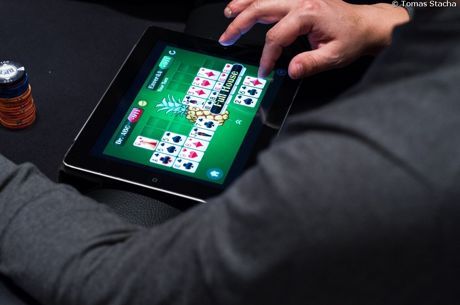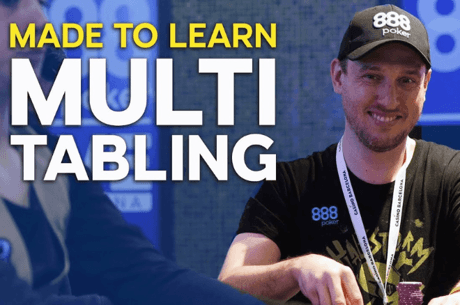Basic No Limit Holdem strategy

When you've learnt the ropes at Limit Holdem and feel like a 'seat of the pants' ride its time to move onto No Limit Holdem and experience the thrill of the game everyone's talking about and watching on TV.
You can easily do this in cash games online, but even better for learning cheaply are Sit'n'gos - or one table tournaments ? where you get a fixed number of chips for your buy-in and therefore a lot of play (and experience) for a low overhead. We'll be looking at specialist tournament ideas later and just focusing on basic strategy and general ideas for now but, as recommended, allocate an amount you're prepared to play out of as a bankroll and chose a fitting level to start at. So if you want to play $5 Sit'n'gos then $100 would probably be ok, but if you want to play $25 cash games (where you sit down with $25 each time) at least $500 would be recommended.
When you first start playing No Limit you'll immediately notice a lot of differences compared to Limit games. You're still playing with the same maniacs and amateurs from the Limit games but their shackles have been removed and many of them are ready and willing to self destruct and play crazy on almost every hand - betting, raising and moving all-in for the thrill of it and the action. By contrast, others are now playing tighter as they fear what the wild players can do to their stack and a few are playing their usual passive compliant game. Meanwhile, the rest are probably trying to mix these various elements to form a winning strategy, which can be called 'tight aggressive', with various degrees of success.
Because you've learnt the basics of Holdem from playing in Limit games you should begin by watching out for the various types of players and playing them accordingly, and getting used to the betting structure. The player types above are the main ones to watch out for and can be approached in the following ways:
Tight aggressive- the type of player you want to be, who doesn't play a lot of hands but plays them strongly and incisively. Tricky and hard to read, such players may bet with a great hand, an average hand, a draw or nothing at all, and are usually sophisticated in their understanding of all aspects of the game. When you identify such players stay out of their way unless you have a good reason (like a big hand) and watch them and learn.
Loose aggressive ? the 'maniac' we've mentioned several times already, who is simply there for the action and loves betting, bluffing and raising more than playing to win. Perhaps it's the style they've seen on TV, perhaps they're drinking or perhaps they're just having fun, these players are dangerous to your stack and even more so to their own. Don't try to bluff or get involved in too many marginal situations with them, but play a few more speculative drawing hands than normal and look for opportunities to get all their chips by checking and calling with big hands when they try to bluff.
Loose passive ? the 'calling station' is a curious breed of opposition, as they do almost exactly the opposite of what they're supposed to, blindly calling with mediocre hands and not making the most of big ones by raising. The reason for this may be blind ignorance or rooted in their personality, but its great news for you as you've found the easiest type of player to compete against ? all you need to do is play showdown poker, where you push your good hands for value and fold the weak ones. Just don't make the mistake of 'getting fancy' against this player or bluffing, as they probably won't even understand what you're trying to accomplish.
Tight passive ? the 'rock' in the game is well known for playing so few hands that when they do raise everyone instantly assumes they have aces and folds! Pay attention to this marked contrast in their behaviour from a good hand to an average hand and it becomes very simple to play against them - all you have to do is bluff a lot as they mostly won't have great hands and fold everything else to a bet, and back off if they suddenly get excited about one.
So now you have some idea of the basics of Holdem and understand the psychological element, the only other things to add to create a winning formula are an introduction to the basic betting patterns and odds employed in No Limit Holdem, as well as discussing what hands you can play. The mathematics and odds will be dealt with in detail later but in terms of choosing how much to bet at any one time and what hands to play you must remember that pre-flop, because of the increased amounts you stand to win if you make a good hand (the 'implied odds') you can play more drawing hands profitably in more positions (although still keeping to those which either allow you to make strong made hands or strong draws is vital when all you chips can be at stake). Also, the freedom of the structure means deception can reap massive rewards, so you might actually raise with suited connectors or small pairs in late position, call with 'gap-connectors' like 6h8h and use position more strongly to bluff or raise other people out of hands.
By contrast, with big starting hands its important to defend them against these draws by raising and making people pay the wrong odds to get there. This can usually be achieved by raising 3-5 times the big blind pre-flop and betting around the size of the pot on the flop and after. Of course you need to have a good 'read' of what the other players are likely to have whilst you're doing this in order to know where they're at, and you might bet actually less if you think you can get them to call with a weak hand that can't improve much or raise you in an attempted bluff. Working all of this out and making the right decision most of the time is the challenge of poker, and in No Limit the decisions you face will often be the toughest and most costly to get wrong. But remember this is all part of the fun, and with experience you'll soon be making others pay for lessons!








